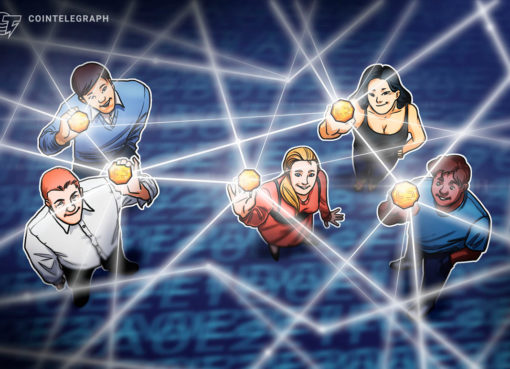In this issue
- U.S. Congress wrestles with another ‘digital dollar’ bill
- Facebook’s Libra scales back ambitions but muscles in on China’s digital currency
- Crypto world in a sweat over ‘bitcoin halving’
- In China: Blockchain Service Network launching soon, Huawei tech zone, and more
- Latest in funding: Atomic Loans in Canada and Airwallex in Hong Kong
From the Editor’s Desk
All roads lead to Rome. In technology this week, this could not be more apparent. From Facebook’s about-face on Libra, to another resurgence of what “digital dollar” could help America implement as it struggles to distribute stimulus money, to China’s continued roll-out of blockchain in enterprise and government… all technology roads are leading us down the same path. Question is: who will control it? There is a divergence emerging between true decentralization and centralized use of blockchain technology.
Compare these two stories side-by-side: New Jersey is desperately searching for COBOL programmers because its antique mainframes can’t handle the avalanche of jobless claims due to the coronavirus, while China is tracking the health of its citizens via digital QR code on your smartphone to curb the spread of the virus.
Amidst Covid-19 realities and startups starved for cash, consolidation is happening. The solid, more promising projects are finding partners, while the others are experiencing the inevitability of their fate far faster than what a more robust market would’ve delayed. And we’re watching this all in real time, quarantined at home. Who will emerge as survivors, and more important, where will most of them be based?
For the first time in history, U.S. oil prices for May this week settled in negative territory. Sellers in effect have become default buyers — where sellers need to pay buyers to take oil off their hands. The Current Forkast remains windy, tornadic and violent as the global economy shakes and shudders from Covid-19. There will be fewer clear paths when the storm passes. The turmoil in the markets, ahistoric and unprecedented, have destroyed many of the roads built by generations before us. So how will you rebuild? The blueprints are being developed today. Technology is already helping define what this future might look like. Enjoy the read, we hope it’ll help you map it out.
Until the next time,
Angie Lau,
Founder and Editor-in-Chief
1. Another look at a U.S. digital dollar
By the numbers: digital dollar — over 5,000% increase in Google search volume.
Yet another bill recommending the use of “digital dollars” for stimulus payments emerges in Congress, this time in the form of the Automatic BOOST to Communities (ABC) Act. Proposed by Congresswomen Rashida Tlaib of Michigan and Pramila Jayapal of Washington, the ABC Act would pay $2,000 per month to every person in America during the Covid-19 outbreak and $1,000 per month for a year following the crisis.
- The bill proposes the establishment of “Digital Dollar Account Wallets” or “FedAccounts” to be made available for use by citizens, residents and businesses.
- On the same day, “crypto dad” and former Commodity Futures Trading Commission Chair J. Christopher Giancarlo explained the difference between the often-proposed “digital dollar” and a central bank digital currency (CBDC) of the Digital Dollar Project.
Forkast.Insights | What does it mean?
Although there’s substantial interest in a CBDC, or a ”digital dollar” being issued by the Fed, realistically it’s going to take quite a bit of time to get such a platform operational. As Giancarlo pointed out, a proper digital dollar is not a stablecoin that simply tokenizes. A digital dollar would have been an efficient way to distribute stimulus — if work had begun on the project years ago. The infrastructure supporting the U.S. unemployment and welfare benefits is written in COBOL, an archaic language so antiquated that most people fluent in it have long retired. It’s the equivalent of not maintaining a bridge to the point of collapse, while at the same time failing to build a replacement. Bulldozing through all of this will take some time; a rush job will lead to more problems. For the sake of perspective, the People’s Bank of China has been working on the digital RMB since 2014 and only now is a launch imminent.
China has ulterior motives to create a digital currency, as recently discussed on Forkast: the liquidity of its currency doesn’t match up to the size of its economy. The U.S. doesn’t have that problem; it does not need to encourage the use of the USD as a reserve currency for settlement as the market already does it organically.
There will be a time for the U.S. to roll out a CBDC, but it looks as if that won’t be during the first iteration of stimulus. It’s already out the door. However, if Covid-19 sticks around for the long haul and frequent stimulus is required for a long period of time, it could be something worth considering. David Treat, a director at the Digital Dollar Project and senior managing director at Accenture, summarized it well in a recent interview with Forkast: “It’s important that the U.S. move, but it’s important that they get it right rather than do it fast.”
2. Libra backs off — and steps into the ring against China’s central bank

By the numbers: Libra — over 5,000% increase in Google search volume.
Facebook retreats on Libra, announcing the coin will now be offered as a series of stablecoins tied to fiat currencies, rather than a singular coin. Facebook, which previously faced global backlash over Libra, still has not been able to shake off criticism and lawmaker scrutiny despite scaling down the project.
- Coinshares CSO Meltem Demirors:
- “no shade to Facebook or Libra, but please just call your project what it is – it’s a payment network for digital IOUs redeemable at the bank of Facebook. not a cryptocurrency. still cool. still interesting. but not a cryptocurrency.”
- NYU business school Professor Scott Galloway:
- “Facebook scaling Libra project back. Was over before it started.”
Forkast.Insights | What does it mean?
If a U.S. CBDC takes time to do right, is a Facebook-run stablecoin a good intermediary in the meantime? Yes.
A stablecoin is not a CBDC, Chris Giancarlo makes that quite clear. However, widespread adoption of stablecoins can be a useful on-ramp to the adoption of CBDC’s. In many ways, Binance’s Project Venus, which was announced last year in response to initial criticisms of Libra, proves this. Binance proposed regional stablecoins tied to local currencies, which in turn would boost the liquidity of the stablecoin (and thus currency) when paired with crypto. This would reduce the costs of cross-border settlement, and encourage regional currencies to be used instead of the USD. Although the success of the stablecoin would be reliant on Binance to maintain the respective reserves of currencies, when you have such a large and well-known entity running things, there isn’t a concern of empty coffers below. All of this would be done in conjunction with government stakeholders.
But that was in 2019. Since then, Binance has gone silent on the project and it’s assumed to be abandoned.
So here’s where Facebook steps in. Libra was initially criticized for being solely tied to the USD, and the possibility of a privately controlled, alternative global currency concerned lawmakers. By moving away from this model, and regionalizing it, Facebook assuages these fears while also providing a very useful platform for cross-border settlement.
Widespread adoption of Libra would also be a solid counter to the ambitions of Beijing with its CBDC. While there is a lot to say about a unique need for a CBDC within China given the success of Alipay and WeChat Pay and the subsequent impact on the money supply, half the reason that the People’s Bank of China is pushing the idea is to build liquidity for the RMB in cross-border settlements. If Libra provides a compelling alternative to this with its regionalized Libra stablecoins, particularly in Southeast Asia, then the PBoC will have some serious competition on its hands.
3. Bitcoin halving: the countdown (for some) to doom

By the numbers: halving — over 5,000% increase in Google search volume.
Bitcoin miner’s reward is expected to be cut in half for the third time in the existence of this grandmother of all crypto. After this halving, expected sometime in May, miners will see their reward drop from 12.5 to 6.25 bitcoins per block.
- Main mining hardware manufacturers such as MicroBT are strengthening their mining rigs line-ups in preparations for the upcoming bitcoin halving. COO Chen Jianbing announced the launch of WhatsMiner M30S+, M30S++ and M31S+ in an online conference.
Just last week, major mining hardware manufacturer Canaan reported steep fourth-quarter losses, highlighting the anticipated challenges for miners and mining hardware manufacturers after the bitcoin halving.
Forkast.Insights | What does it mean?
Bitcoin’s scheduled decrease in reward to miners cannot come at a worse time for mining equipment manufacturers. A “death cross” of a reduction in rewards given to miners as well as a violent drop in crypto commodity prices have put considerable pressure on miners. With bitcoin mining no longer as lucrative as it once was and miners needing to work harder than ever to earn their coins, these companies are seeing a surge of cancellations along with softening demand for their product.
To counter this, mining companies are spending big R&D bucks to develop cheaper, more efficient silicon that can make mining profitable even in these turbulent times. This is nothing new. Think about the move to application-specific integrated circuit (ASIC)-based mining, which uses specialized silicon, away from the mining based on graphic processing units (GPUs) from early 2014 because of that year’s version of the halving and the need to innovate. Innovation is always possible. But one problem we learned from Canaan’s latest earnings report is that the company is spending a fraction on R&D as its competitors are. As the only public company in the mining space, Canaan’s woes will reflect badly on the industry at large even if its peers, like Bitmain, are able to create the next big thing in mining silicon. Canaan, specifically, says it intends to pivot away from just producing silicon for bitcoin mining but we’ll see if that’s even possible with its low R&D spend. Although, for Canaan, this might be the least of its concerns for now. It is also facing a lawsuit filed by disgruntled investors that levies some pretty serious allegations about the validity and the truthfulness of its fundamentals going into its IPO. How this lawsuit proceeds may have serious implications on the industry as a whole.
4. In China: New national blockchain platform, Huawei’s IT demo zone, and blockchain firm busted for sketchy masks

China’s hotly anticipated Blockchain-based Service Network (BSN) — the national blockchain platform led by State Information Center and backed by large enterprises like China UnionPay and China Mobile Communications Co. — is set to launch on April 25, according to the BSN’s official announcement.
- BSN is intended to build a global infrastructure network to help companies produce all kinds of blockchain applications faster and cheaper.
- Since plans for BSN were initially revealed on October 15, 2019, it has led to the creation of around 100 public city nodes with three Chinese telecom giants, with another 100 in the works by the end of 2020, according to the BSN White Paper published in February 2020.
- At BSN’s Commercial Launch Conference in Beijing on April 25, the BSN Development Association (BSNDA) is expected to give a thorough introduction of the new platform, including BSN’s commercial price system, the up-to-date deployment of domestic and overseas public city nodes, a detailed analysis of BSN’s frameworks, and an updated BSN White Paper. Due to Covid-19, guests will be able to join the conference online and Chinese media, including People.cn, will live-stream the event.
Forkast.Insights | What does it mean?
The BSN isn’t the first “service network” for blockchain, as many cloud providers like Amazon and Azure offer similar platforms to help their clients quickly integrate blockchain into their stack. What’s important, however, is the sheer scale of China’s new platform. With this insane scale, dApps built on the platform can now have a huge user base, with minimal hosting costs. Small and medium-sized enterprises have one less barrier for blockchain adoption.
The scale of the BSN is also going to put China ahead of the curve for forcing standards on the world. While the International Organization for Standardization (ISO) is headquartered in Geneva, the “ISO of blockchain” might be in Guangzhou. The underlying software layer developed by the Financial Blockchain Shenzhen Consortium, which counts Tencent, Huawei, and ZTE as members, initially based its code on Ethereum, but it has since been forked and is now something almost unrecognizable. When this takes off, future developers are going to be looking at China’s code and standards as the example — meaning China will very likely have a large say in future blockchain development worldwide.

Global Times reports that smartphone giant Huawei Technologies has signed an agreement with Nanshan District’s government of Shenzhen to jointly build the Kunpeng industry demonstration zone (鲲鹏产业示范区).
- The industry demonstration zone aims to be an IT center, focusing on model chipsets production and speeding up the application of technologies like blockchain, artificial intelligence, big data and 5G.
- Huawei is expected to play the role of technology developer, gathering industries and attracting talents in building the Kunpeng industry demonstration zone and national Kunpeng industrial and ecological chain.
- Separately, People.cn published a story on April 18 headlined, “New Infrastructure Observation: The Traceability of Blockchain Technology.” People.cn acknowledges blockchain technology as an important component of new infrastructure that helps enhance the efficiency of the real economy in multiple areas, including supply chain management, credit investigation system and finance.
- “Stepping into 2020, a growing number of blockchain-supporting policies are made by central and local governments,” according to the People.cn article. “Many blockchain programs are regarded as key projects in Jiangxi and Hunan…. The total investment is around a billion yuan.”
Forkast.Insights | What does it mean?
In many ways the success of China’s push to become a leader in blockchain technology is because of the country’s approach to government-led development and capitalism. Government sets the goals, the market follows with solutions. Trust in the integrity of the supply chain, whether that be for credit worthiness, food, or manufacturing is something that China’s government has identified as an issue that needs to be addressed. In response, industry has moved towards providing solutions, and initiatives such as the Kunpeng industry demonstration zone are examples of this.
Within the United States there are also a plethora of pain points blockchain can address. Take title insurance, for instance. The uniquely American issue of defects in title to a property — and the need to have an insurance policy against this — stems from the lack of centralization of records. Blockchain could transform this industry by allowing title agents to share data amongst themselves when certifying the chain of title to a property is clean, thereby reducing fraud and the repetition of notarization. While there are some efforts to fix this, none have the scale and urgency of China’s state-led efforts. There’s no, say, San Antonio industry demonstration zone, to match efforts in Kunpeng and across the mainland. However, this could change. As part of the economic stimulus efforts post Covid-19, major infrastructure spending is a sure thing. Airports, public transit networks, and highways are all public goods that could benefit from stimulus spending. Why not extend this spending to improving the infrastructure of commerce? This could be what’s needed to get an American CBDC off the ground, or embed blockchain in crumbling systems and archaic processes that are killing efficiency.

Two technology companies, including a blockchain firm, are now banned from exporting disease-prevention medical supplies due to poor quality, according to the Ministry of Commerce of China.
- Foreign importers have returned the substandard face masks made by Beijing Qidi Blockchain Technology, also known as TUS Data Asset, and Shenzhen Aibaoda Technology. “It disrupted the order of exporting epidemic prevention supplies and seriously affected the nation’s image,” the Ministry of Commerce said.
- TUS Data Asset is a state-owned blockchain technology company, founded in Tsinghua University and focuses on science and technology services. The blockchain company only recently added sales of class I and class II medical devices to its business.
- TUS Data Asset has expressed regrets for buying and exporting substandard face masks: “Due to the lack of experience, we chose the wrong suppliers and made mistakes that caused negative impacts to the society. We sincerely apologize for it.”
Forkast.Insights | What does it mean?
The Covid-19 pandemic has brought out the best in people and corporations, with many companies stepping up to the plate to pivot their manufacturing capabilities to make personal protective equipment for healthcare workers and ventilators for hospitals. That being said, opportunism can also get the worst of people as the temptation to make easy money can be overwhelming.
Blockchain and crypto already sometimes have a less-than-stellar reputation, so public shaming of companies that use a pandemic to make an opportunistic buck is well-warranted. As reported on Forkast, entrepreneurs in China will often add “blockchain” to their company’s name, just to have their company stand out even if the firm’s business has nothing to do with blockchain technology.
5. Funding roundup: Hong Kong and Canada
Canada: Atomic Loans, seed, $2.5 million USD
In the midst of a city in lockdown, Toronto’s Atomic Loans announced that it had secured a seed round of $2.5 million led by Initialized Capital and Joseph Lubin’s ConsenSys. Atomic Loans proposes a non-custodial method of securing crypto assets for a loan, using smart contracts instead of storage. As discussed before on Forkast News, loans secured by crypto assets are going to be a major emerging sector of DeFi because they provide a tax-efficient way to offramp crypto assets into fiat currency to invest elsewhere without creating a taxable event. However, this is all predicated on tax authorities not changing how this is structured — or creating some sort of crypto exemption.
Hong Kong: Airwallex, Series D, $160 million USD
Challenger banks that promise to reduce the cost of cross-border transactions have become all the rage in the last year, with TransferWise, founded by Skype alumni, leading the charge to reduce the friction costs of forex. Having come off a $100 million round last year, Airwallex announced this week that it has raised a Series D round led by Salesforce Ventures and Tencent Holdings. Airwallex has momentum, but the market is crowded. After this round, will it be able to push on against more nimble competitors like TransferWise and Revolout?




